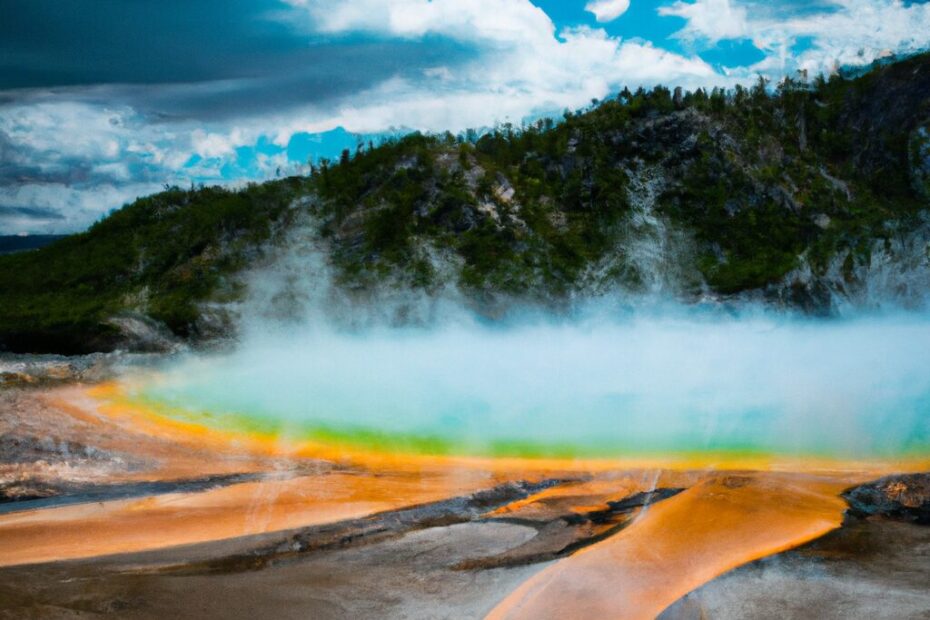Yellowstone National Park is home to some of the most incredible geysers in the world. From the iconic Old Faithful to the lesser-known gems scattered throughout the park, these natural wonders never fail to captivate visitors. But with their beauty comes potential danger.
In this article, we will explore the types of geysers found in Yellowstone, what makes them unique, and the safety guidelines you need to follow to ensure a memorable, yet safe, visit to these extraordinary natural wonders.
What Are Geysers?
Geysers are natural hydrothermal features that erupt hot water and steam from the Earth’s surface due to volcanic activity, creating spectacular displays of nature’s power.
Geysers are unique formations typically found in areas with geothermal activity, such as Yellowstone National Park. This is because the underground heat from molten rock reservoirs creates the conditions for geysers to form.
The eruption of a geyser is caused by the superheating of water trapped beneath the Earth’s surface. This leads to the build-up of pressure until it eventually forces its way out in a powerful release. Geysers are known for their cyclic nature, with periods of dormancy followed by intense eruptions.
However, it’s important to note that while geysers are mesmerizing to witness, they also pose potential dangers. This emphasizes the importance of following geothermal safety guidelines to ensure visitors can enjoy these natural wonders responsibly.
Where Can You Find Geysers?
Geysers are prominently found in Yellowstone National Park, where a diverse collection of these geothermal features captivate and awe visitors with their natural grandeur.
The park’s iconic Old Faithful geyser is one of the most famous and predictable geysers in the world, erupting approximately every 90 minutes.
Visitors can also explore other geysers such as Steamboat, Beehive, and Grand Prismatic Spring, each offering a unique display of natural hydrothermal activity.
The park’s management team emphasizes the importance of responsible visitor behavior around geysers, educating guests about the potential dangers and fragility of these natural formations.
This educational approach enhances the overall experience, fostering a deeper appreciation for Yellowstone’s geothermal wonders.
What Are the Types of Geysers in Yellowstone?
Yellowstone features various types of geysers, including cone geysers, fountain geysers, fountain cone geysers, and other distinct formations, each showcasing different eruptive patterns and geological characteristics.
Cone geysers, such as Old Faithful, erupt with a single powerful stream of water, while fountain geysers, like Great Fountain Geyser, produce tall, vigorous bursts of water and steam.
Fountain cone geysers, such as Castle Geyser, combine features of both cone and fountain geysers, creating a mesmerizing display. These geysers are formed due to underground water reservoirs reaching boiling point and the subsequent release of pressure causing eruptions.
Park regulations strictly forbid visitors from approaching or interfering with these natural wonders to ensure both safety and preservation of the geothermal features.
Cone Geysers
Cone geysers in Yellowstone are characterized by their cone-shaped formations and periodic eruptions that propel scalding water and steam into the air, offering mesmerizing displays of natural phenomena.
These cone geysers exhibit unique eruptive behavior, with some erupting regularly while others are more irregular in their activity.
The cone-shaped formations are the result of mineral deposits left behind by the escaping water, adding to the distinctiveness of these geological features.
When visiting these geysers, it’s important to adhere to safety measures, such as staying within designated viewing areas and following park guidelines to avoid accidents and ensure a safe experience.
Fountain Geysers
Fountain geysers found in Yellowstone exhibit unique eruptive patterns, propelling hot water and steam in a fountain-like fashion, creating mesmerizing spectacles of geothermal activity and natural beauty.
Fountain geysers are famous for their sporadic and unpredictable eruptions, making each display an exciting and unexpected sight for spectators.
The geological formations that surround these geysers are adorned with vibrant mineral deposits and intricate terraces, further adding to their allure.
For the safety of both visitors and the delicate ecosystem, it is crucial to follow the recommended guidelines and maintain a safe distance from the geysers to avoid scalding from the boiling hot water.
Preserving these sites is vital to ensure the continued existence of this unique natural phenomenon for generations to come.
Fountain Cone Geysers
The combination of cone and fountain eruptions defines the captivating nature of fountain cone geysers in Yellowstone, where alternating displays of water and steam create a remarkable showcase of geothermal activity and natural wonders.
These unique geysers form stunning geological formations as their eruptions sculpt the surrounding landscape over time. Visitors are mesmerized by the sudden bursts of water shooting upward and then cascading down in graceful arcs, while the steam billows and dances in the air.
The experience of witnessing such eruptive behavior is both exhilarating and humbling, underlining the raw power of nature. Proper safety precautions are essential when viewing these geysers, as the scalding-hot water and steam demand a respectful distance and environmental sensitivity.
Other Types of Geysers
Yellowstone National Park is home to a variety of geysers, each with its own unique characteristics. Some erupt intermittently, while others have a constant, steady flow. These geysers are an integral part of the park’s geothermal wonders, adding to its diverse landscape.
By exploring these geysers, visitors can gain a deeper understanding of the powerful forces at work beneath the Earth’s surface. It also highlights the importance of geothermal safety and environmental conservation in preserving these valuable natural resources for future generations.
What Makes Yellowstone Geysers Unique?
The geysers of Yellowstone hold a distinct allure due to their status as natural wonders, showcasing unparalleled geological phenomena and contributing to the park’s reputation as a hotspot for geothermal activity.
Their distinctive eruptions captivate the imaginations of visitors as they witness the raw power of these geothermal features. These geysers, such as the famous Old Faithful, are not only awe-inspiring sights but also serve as a reminder of the earth’s active geological processes.
While admiring their beauty, it’s important for visitors to adhere to safety measures to prevent accidents and protect the unique ecosystems surrounding these geysers. The environmental impact of these geothermal phenomena further underscores the importance of conservation efforts within the park, recognizing the delicate balance between preservation and exploration.
What Are the Dangers of Geysers?
While captivating, Yellowstone’s geysers pose potential dangers to visitors. These include the risk of hot water and steam burns, the threat of falling into geothermal features, and the presence of toxic gases in certain areas.
It is crucial for visitors to adhere to strict visitor safety tips when exploring these natural wonders. One should be mindful of the designated paths, never stray off marked trails, and avoid getting too close to the geysers or hot springs.
Understanding and following environmental guidelines can help protect both visitors and the unique ecosystem of Yellowstone. By staying informed and cautious, visitors can fully enjoy the beauty of the park while minimizing the risks associated with its geothermal features.
Hot Water and Steam Burns
The scalding hot water and steam emitted by geysers in Yellowstone pose a significant danger to visitors, capable of causing severe burns and injuries if safety precautions are not followed with utmost caution.
When visiting geysers, it is important to be aware of the potential risks and to follow designated walkways and safety barriers. These natural formations are unpredictable, so it is crucial to exercise extreme caution and avoid touching or entering the thermal features.
Educating oneself about geyser safety and understanding the natural processes behind these wonders can greatly reduce the chances of accidents. Park authorities have also taken steps to enhance visitor education on thermal safety, emphasizing the importance of respecting the boundaries around geysers and hot springs.
Falling Into a Geyser
The prospect of falling into a geyser within Yellowstone presents a grave danger, as the scalding water and perilous surroundings pose a severe risk to visitors, requiring strict adherence to safety guidelines and regulations.
When visiting Yellowstone, it is crucial for visitors to prioritize their safety. This means staying on designated paths and avoiding roped-off areas around the geysers. It is important to heed warning signs and not approach the thermal features, as the ground may be dangerously fragile.
In the event of witnessing someone fall into a geyser, it is essential to immediately contact park rangers and utilize emergency protocols. Understanding visitor responsibility plays a vital role in upholding park safety, preventing avoidable accidents, and ensuring a memorable and safe experience for all.
Toxic Gases
Certain geothermal areas in Yellowstone release toxic gases that can pose a threat to visitor safety, necessitating awareness of warning signs and adherence to safety measures to mitigate the risks of exposure.
Toxic gases, such as hydrogen sulfide and carbon dioxide, are naturally emitted from the Earth’s crust and can be harmful if inhaled in large quantities. Yellowstone National Park has put in place specific regulations and safety information to educate visitors about these potential dangers, including warning signs in key areas.
It’s crucial for visitors to stay on designated paths and avoid lingering in low-lying areas where these gases may accumulate. Being mindful of any sudden changes in air quality can help ensure a safe and enjoyable visit to these unique natural wonders.
How Can You Stay Safe While Visiting Yellowstone Geysers?
Visitors to Yellowstone can ensure their safety while observing geysers by following essential safety guidelines, respecting park regulations, and being mindful of the potential hazards associated with these extraordinary natural features.
It is crucial for visitors to stay on designated boardwalks and trails, as the thin crust covering the geothermal areas may be unstable and unsafe.
Maintaining a safe distance from the geysers and hot springs is imperative to prevent accidental burns or injuries.
It’s important to keep a watchful eye on children and pets at all times to ensure their safety.
It’s vital to heed all warning signs and not attempt to touch the scalding hot water or enter restricted areas, as this can pose significant risks to both personal safety and environmental preservation.
Follow Park Rules and Regulations
Adherence to Yellowstone’s park rules and regulations, as communicated by park rangers and visitor centers, is crucial for maintaining visitor safety and environmental conservation when exploring the park’s geothermal wonders.
By respecting the guidelines set forth, visitors can enjoy the stunning scenery and unique wildlife while ensuring that the delicate ecosystems remain undisturbed.
Safety signage strategically placed throughout the park serves as visual reminders for hikers and explorers, helping to prevent accidents and minimize human impact.
Educational programs offered at visitor centers equip guests with knowledge about the park’s fragility and the importance of responsible stewardship.
Being informed and compliant not only enhances the experience but also contributes to the longevity of Yellowstone’s natural splendor.
Stay on Designated Paths and Boardwalks
Remaining on designated paths and boardwalks around geysers in Yellowstone is essential for ensuring visitor safety and maintaining a safe distance from these natural marvels, underscoring the significance of visitor education and awareness.
Educational signage and safety precautions play a crucial role in informing visitors about the potential dangers of straying off the designated paths near geysers.
By adhering to these guidelines, visitors contribute to the preservation of these delicate ecosystems while protecting themselves from potential hazards.
The National Park Service’s ongoing efforts in educating and raising awareness among visitors about responsible behavior near geysers ensure a safe and enjoyable experience for all.
Keep a Safe Distance from Geysers and Hot Springs
Maintaining a safe distance from geysers and hot springs in Yellowstone is imperative to avoid potential danger and demonstrate responsible behavior when witnessing these captivating natural phenomena.
Yellowstone National Park is home to unique geological features that can reach scalding temperatures and pose unpredictable hazards. As such, it’s crucial for visitors to follow safety rules and stick to designated viewing areas.
Not only does ignoring these precautions put individuals at risk, but it also threatens the delicate ecological balance of Yellowstone’s geothermal areas. By respecting the guidelines in place, visitors can fully appreciate the park’s natural beauty while ensuring their own safety and preserving these mesmerizing natural wonders.
Do Not Touch or Throw Objects into Geysers
Respecting the sanctity of geysers in Yellowstone involves refraining from touching or throwing objects into these fragile natural features. This helps preserve their natural beauty and adhering to established safety guidelines.
It is imperative to recognize the significance of environmental preservation and abide by safety recommendations when exploring these wonders.
Utilizing safety gear and equipment not only protects visitors from potential harm but also ensures the preservation of the geothermal features for future generations.
By being mindful of the impact our actions have on these delicate ecosystems, we can collectively contribute to the continued conservation of these natural marvels.
Be Prepared for Changing Weather Conditions
Being prepared for changing weather conditions during visits to Yellowstone’s geysers is essential, requiring caution and the readiness to respond to potential emergency situations that may arise due to unpredictable environmental factors.
To fully enjoy and stay safe amidst Yellowstone’s diverse landscapes, it’s crucial to understand safety protocols and have access to safety information. The park’s geothermal features, such as geysers, can quickly change, so visitors should always have appropriate clothing and supplies for varying conditions.
By staying informed and prepared, visitors can mitigate potential risks while still marveling at the stunning natural beauty of the region. So be sure to plan ahead and stay updated on any safety advisories during your visit to Yellowstone.
Know What to Do in Case of an Emergency
Understanding the appropriate steps to take in the event of an emergency near geysers in Yellowstone, including the supervision of children and adherence to park rules and regulations, is vital for ensuring visitor safety and well-being.
When visiting Yellowstone, it’s important to remember to always maintain a safe distance from thermal features and stay on designated trails. This is because the ground can be unstable and dangerous. In case of an emergency, it’s crucial to notify park rangers immediately and follow their guidance.
Another important aspect of responsible visitor behavior is educating children about the dangers of hot springs and geysers. This can help prevent accidents and keep everyone safe. Additionally, it’s important to pack out all trash and respect the wildlife in the park.
By following these safety precautions and being mindful of visitor responsibility, we can all enjoy the unique beauty of Yellowstone while minimizing risks and preserving the natural environment for future generations.
Frequently Asked Questions
What are the safety guidelines for visiting Yellowstone geysers?
Visitors must stay on designated boardwalks, follow park signs and warnings, and keep a safe distance from geysers at all times.
Why is it important to follow safety guidelines at Yellowstone geysers?
Yellowstone geysers are unpredictable and can be dangerous. Following safety guidelines helps protect visitors and preserve the natural wonders of the park.
Can I touch or step into the geysers at Yellowstone?
No, it is strictly prohibited to touch or step into geysers at Yellowstone. The hot temperatures and high pressure can cause serious injuries.
Are there any additional safety precautions I should take while visiting Yellowstone geysers?
Yes, it is important to stay hydrated, wear appropriate footwear, and be aware of your surroundings at all times. It is also recommended to stay on the designated paths to avoid disturbing the delicate ecosystem.
What should I do if I see someone not following the safety guidelines at Yellowstone geysers?
Visitors are encouraged to politely remind others to follow the guidelines. If there is a serious safety concern, it is best to notify a park ranger immediately.
Are children allowed to visit Yellowstone geysers?
Yes, children are allowed to visit Yellowstone geysers, but they must be closely supervised by adults and follow all safety guidelines. It is also important to educate children about the dangers of geysers and the importance of following park rules.
Last Updated on January 25, 2024 by Jon Waraas – Originally Posted: January 25, 2024

I’m Jon Waraas, and I’ve been navigating the online world since 2006. By day, I’m the proud owner of some eCommerce gems, and by night, I’m the voice behind the adventures on Waraas.Com.
My heart, however, belongs to the wild beauty of Yellowstone National Park. I’ve got a collection of websites dedicated to sharing the wonders of this natural masterpiece. Oh, and did I mention? I’m currently building my own cabin inside the ghost town of Gilmore, Idaho – a cabin with tales to tell!
When I’m not immersed in the digital realm, you’ll find me lacing up my boots for a good hike or setting up camp under the star-studded sky.




